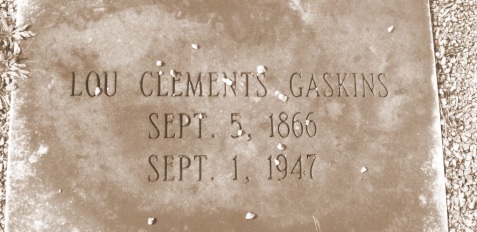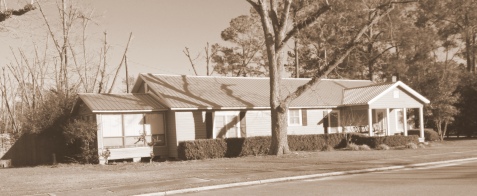Gideon D. Gaskins
Gideon D. Gaskins was born September 15, 1859 and raised in the vicinity of Ray’s Mill, GA. His father was William Gaskins and his mother was Elizabeth Clements. The Berrien County tax digests of 1884-1886 show the twenty-something young Gideon Gaskins in the 1144 Georgia Militia District, the Ray’s Mill district, although he was not a land owner.
On October 17, 1886, Gideon D. Gaskins married Lourene “Lula” Clements in Berrien County, GA.
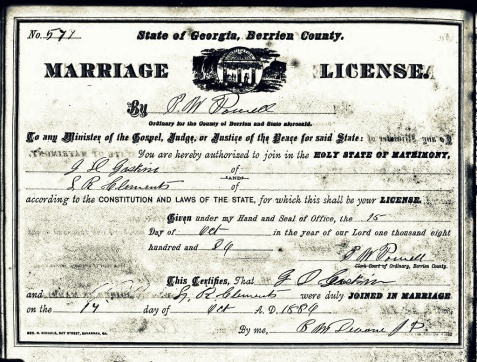
Marriage Certificate of Gideon D. Gaskins and Lula R. Clements, October 17, 1886, Berrien County, GA
Lula was born September 5, 1866, a daughter of John C. Clements and Mary Patten.
Some time before 1887, Gideon Gaskins moved his family to Willacoochee, GA where he worked as a merchant. The 1887 property tax digest show “Giddie” Gaskins owned property in the town of Willacoochee valued at $135, and $25 worth of household furnishings. His stock of merchandise was valued at $300. The 1890 property tax digests show Gaskins’ town property in Willacoochee valued at $200, as well as $50 in household furnishings and $20 in livestock.
An 1898 society item from offered a tongue-in-cheek critique of the Willacoochee merchant’s physique. Gaskin’s fellow businessmen and neighbors were: Albert Padgett, merchant; William L. Moore, merchant; Joe Vickers, merchant; Henry Paulk, merchant. Gid Gaskins was apparently leaner and cleaner shaven than his colleagues.
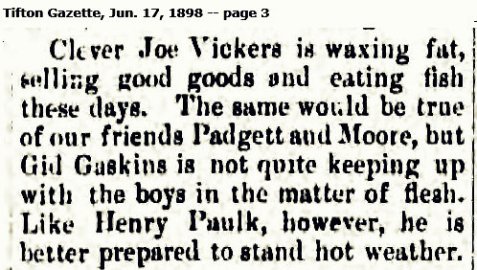
1898 personal mention of Gid Gaskins, merchant of Willacoochee, GA
Tifton Gazette
June 17, 1898
Clever Joe Vickers is waxing fat, selling good goods and eating fish these days. The same would be true of our friends Padgett and Moore, but Gid Gaskins is not quite keeping up with the boys in the matter of flesh. Like Henry Paulk, however, he is better prepared to stand hot weather.
In the census of 1900, Gideon Gaskins gave his occupation as merchant and indicated he was working as a wage employee. By 1902, Willacoochee was a growing concern and Gideon was ready to run his own shop. He built a brick store in Willacoochee on the south side of the tracks of the Brunswick and Western Railroad. The Brunswick & Western Railroad ran 171 miles from Brunswick, GA to Albany, GA passing through Waynesville, Waycross, Waresboro, Pearson, Sniff, Kirkland, Pinebloom, Willacoochee, Alapaha, Enigma, Brookfield, Vanceville, Tifton and other towns. In the 1870s and 80s the Brunswick & Western had been the stomping grounds of the notorious outlaw Ben Furlong; in the 1900s Jack Alsea “Joe” Furlong, son of Ben Furlong, was residing at Willacoochee, GA in the household of his foster parents Benjamin B. Gray and Ellen Gray .
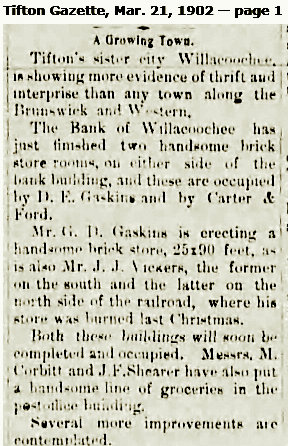
Tifton Gazette
March 21, 1902
A Growing Town
Tifton’s sister city Willacoochee is showing more evidence of thrift and interprise than any town along the Brunswick and Western.
The Bank of Willacoochee has just finished two handsome brick store rooms on either side of the bank building, and these are occupied by D. E. Gaskins and by Carter & Ford.
Mr. G. D. Gaskins is erecting a handsome brick store, 25×90 feet, as is also Mr. J. J. Vickers, the former on the south and the latter on the north side of the railroad, where his store was burned last Christmas.
Both these buildings will soon be completed and occupied. Messrs. M. Corbitt and J. F. Shearer have also put a handsome line of groceries in the post office building.
Several more improvements are contemplated.
Gideon D. Gaskins and Lula Clements had only one child, Mattie Mae Gaskins, born October 10, 1890. A 1904 news clipping from the Tifton Gazette suggests that Mattie Gaskins may have attended the Sparks Institute as a teen ager.
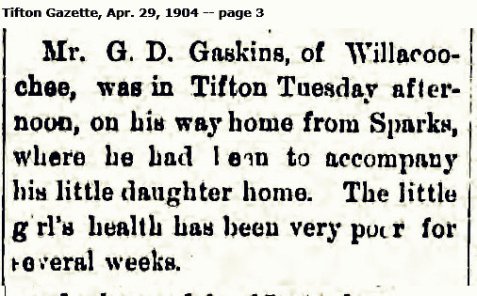
The 1910 census records show that Gideon’s nephew, Thomas R. Cox, had come to live with the Gaskins in Willacoochee by that time. It was a banner year for Willacoochee in 1910. The opening of the line of the Georgia & Florida on October 1, 1908 had brought a second railroad to the town and by 1910 the town was experiencing a boom in construction. The Peoples Bank building went up, along with half a dozen still-existing brick and wood commercial buildings. and the Willacoochee Electric Plant. And in 1910, the Oak View Hotel was built in Willacoochee; Gideon Gaskins would be the proprietor.
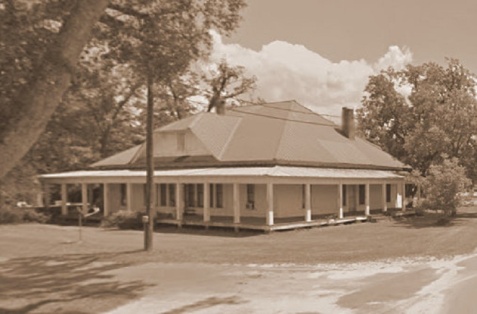
The former Oak View Hotel, Willacoochee, GA, with its distinctive jerkinhead (clipped gable) roof line. The jerkinhead design roof was stronger, but more expensive than a conventional hip gable roof.
The former Oak View hotel still stands on the corner of McCranie Street and Gaskins Street in Willacoochee, GA. The hotel was built in a prime location, one block south of the tracks of the Brunswick & Western Railroad and two blocks east of the depot of the recently opened Georgia & Florida Railroad. After 1908, the route of the G&F was from Jacksonville, GA to Madison, FL and provided convenient transportation between Willacoochee and Ray City by way of Nashville, GA, a run of about 34 miles. The Gaskins were one of many south Georgia families that shared a Ray City – Willacoochee connection.
The costs of constructing the Oak View Hotel may have strained Gideon D. Gaskins’ finances. In 1910 he received a judgment of bankruptcy, but later determined that he would be able to make good on all his debts.
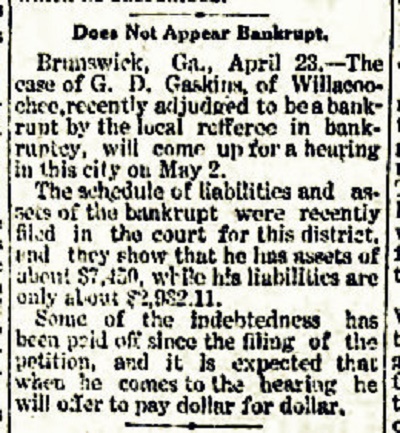
Tifton Gazette
April 29, 1910
Does Not Appear Bankrupt
Brunswick, Ga., April 23. – The case of G. D. Gaskins of Willacoochee, recently adjudged to be a bankrupt by the local refferee in bankruptcy, will come up for a hearing in this city on May 2.
The schedule of liabilities and assets of the bankrupt were recently filed in the court for this district, and they show that he has assets of about $7,450, while his liabilities are only about $2,982.11.
Some of the indebtedness has been paid off since the filing of the petition, and it is expected that when he comes to the hearing he will offer to pay dollar for dollar.
Despite earlier struggles, business was good in Willacoochee. By 1916 Gideon’s nephew, Thomas R. Cox, had secured a position as bookkeeper for the Bank of Willacoochee. When Cox disappeared in May, 1916 there were allegations of malfeasance.
Gideon D. Gaskins died at his home in Willacoochee, GA on October 23, 1916.
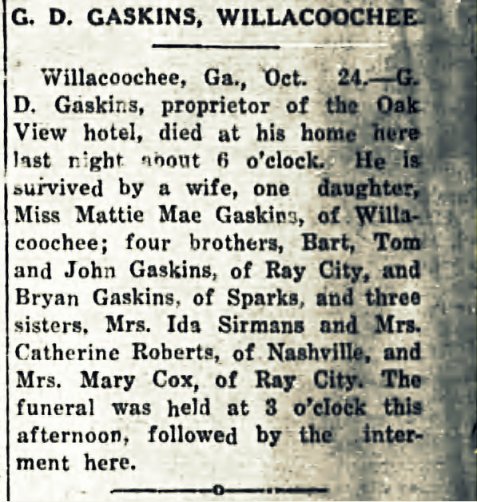
Death of Gideon D. Gaskins reported in the Tifton Gazette
Obituary
The Tifton Gazette
Oct 27, 1916
G. D. Gaskins, Willacoochee.
Willacoochee, Ga., October 24.-(Special.)- G .D. Gaskins, proprietor of the Oak View hotel and a well-known citizen of this county, died at his home here last night about 6 o’clock. He is survived by a wife, one daughter, Miss Mattie Mae Gaskins, of Willacoochee; four brothers, Bart, Tom and John Gaskins of Ray City, and Bryan Gaskins, of Sparks, and three sisters, Mrs. Ida Sirmans, and Mrs. Catherine Roberts of Nashville, and Mrs. Mary Cox of Ray City. The funeral was held at 3 o’clock this afternoon, followed by the interment here.
The grave of Gideon D. Gaskins lies in the Willacoochee City Cemetery.
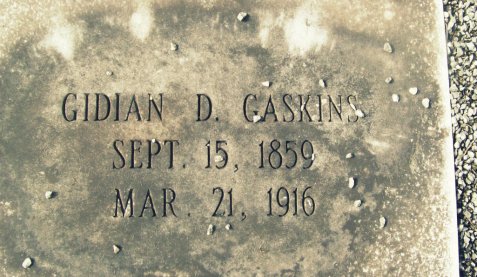
Grave of Gideon D. Gaskins, Willacoochee City Cemetery, Willacoochee, GA. Image source: Barbara L. Kirkland
The information from the grave marker is somewhat problematic. First, the given name on the grave does not follow the expected spelling – “Gidian” instead of “Gideon.” Second, the date of death on the grave -March 21, 1916 – does not match with obituaries published in local and state newspapers which clearly establish the date of death as October 23, 1916. It appears that the marker on the grave of Gideon D. Gaskins was placed well after the time of his death, perhaps after the time of his wife’s death, and that the date of his passing or even the spelling of his name was not well known to those tending his grave.
After the death of Gideon D. Gaskins his widow, Lula Clements Gaskins, operated the Oak View Hotel for a few years, then returned to Ray City, GA with her daughter, Mattie Mae Gaskins. They lived in a house on Main Street, Ray City, until Lula’s death in 1947.






















